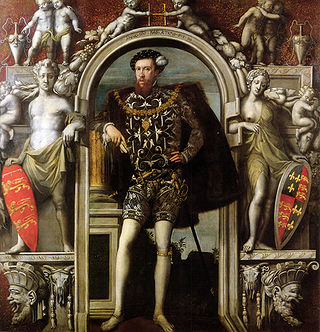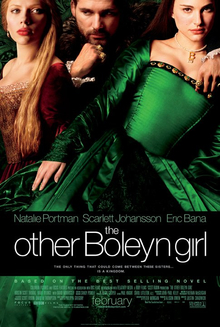
Anne Boleyn was Queen of England from 1533 to 1536, as the second wife of King Henry VIII. The circumstances of her marriage and execution, by beheading for treason, made her a key figure in the political and religious upheaval that marked the start of the English Reformation.

Anne of the Thousand Days is a 1969 British historical drama film based on the life of Anne Boleyn, directed by Charles Jarrott and produced by Hal B. Wallis. The screenplay by Bridget Boland and John Hale is an adaptation of the 1948 play of the same name by Maxwell Anderson.

Thomas Boleyn, Earl of Wiltshire, 1st Earl of Ormond, 1st Viscount RochfordKGKB, of Hever Castle in Kent, was an English diplomat and politician who was the father of Anne Boleyn, the second wife of King Henry VIII, and was thus the maternal grandfather of Queen Elizabeth I. By Henry VIII he was made a knight of the Garter in 1523 and was elevated to the peerage as Viscount Rochford in 1525 and in 1529 was further ennobled as Earl of Wiltshire and Earl of Ormond.

Sir Thomas Wyatt was a 16th-century English politician, ambassador, and lyric poet credited with introducing the sonnet to English literature. He was born at Allington Castle near Maidstone in Kent, though the family was originally from Yorkshire. His family adopted the Lancastrian side in the Wars of the Roses. His mother was Anne Skinner, and his father Henry, who had earlier been imprisoned and tortured by Richard III, had been a Privy Councillor of Henry VII and remained a trusted adviser when Henry VIII ascended the throne in 1509.

Henry Howard, Earl of Surrey, KG was an English nobleman, politician and poet. He was one of the founders of English Renaissance poetry and was the last known person to have been executed at the insistence of King Henry VIII. His name is usually associated in literature with that of the poet Sir Thomas Wyatt. Owing largely to the powerful position of his father Thomas Howard, 3rd Duke of Norfolk, Henry took a prominent part in court life, and served as a soldier both in France and in Scotland. He was a man of reckless temper, which involved him in many quarrels, and finally brought upon him the wrath of the ageing Henry VIII. He was arrested, tried for treason and beheaded on Tower Hill.
Jane Boleyn, Viscountess Rochford was an English noblewoman. Her husband, George Boleyn, Viscount Rochford, was the brother of Anne Boleyn, the second wife of King Henry VIII, and a cousin to King Henry VIII's fifth wife Catherine Howard, making Jane a cousin-in-law. Jane had been a member of the household of Henry's first wife, Catherine of Aragon. It is possible that she played a role in the verdicts against, and subsequent executions of, her husband and Anne Boleyn. She was later a lady-in-waiting to Henry's third and fourth wives, and then to his fifth wife, Catherine Howard, with whom she was executed.

George Boleyn, Viscount Rochford was an English courtier and nobleman who played a prominent role in the politics of the early 1530s as the brother of Anne Boleyn, second wife of King Henry VIII. George was the maternal uncle of Queen Elizabeth I, although he died long before his niece ascended the throne. Following his father's promotion in the peerage in 1529 to Earl of Wiltshire and Earl of Ormond, he adopted his father's junior title Viscount Rochford as a courtesy title. He was accused of incest with his sister Anne during the period of her trial for high treason, as a result of which both were executed.
Mark Smeaton was a musician at the court of Henry VIII of England, in the household of Queen Anne Boleyn. Smeaton – together with the Queen's brother George Boleyn, Viscount Rochford; Henry Norris, Francis Weston, and William Brereton – was executed for treason and adultery with Queen Anne.

The Other Boleyn Girl (2001) is a historical novel written by British author Philippa Gregory, loosely based on the life of 16th-century aristocrat Mary Boleyn of whom little is known. Inspired by Mary's life story, Gregory depicts the annulment of one of the most significant royal marriages in English history and conveys the urgency of the need for a male heir to the throne. Much of the history is highly distorted in her account.
William Brereton, c. 1487/1490 – 17 May 1536, was a member of a prominent Cheshire family who served as a courtier to Henry VIII. In May 1536, Brereton was accused of committing adultery with Anne Boleyn, the king's second wife, and executed for treason along with her brother George Boleyn, Henry Norris, Francis Weston and a musician, Mark Smeaton. Most historians are now of the opinion that Anne Boleyn, Brereton and their co-accused were innocent.

The Other Boleyn Girl is a 2008 historical romantic drama film directed by Justin Chadwick. The screenplay by Peter Morgan was adapted from Philippa Gregory’s 2001 novel of the same name. It is a fictionalised account of the lives of 16th-century English aristocrats Mary Boleyn, mistress of King Henry VIII, and her sister, Anne, who became the monarch's ill-fated second wife.

The Tudors is a British-Canadian historical fiction television series set primarily in 16th-century England, created and written by Michael Hirst and produced for the American premium cable television channel Showtime. The series was a collaboration among American, British, and Canadian producers, and was filmed mostly in Ireland. While named after the Tudor dynasty as a whole, it is based specifically upon the reign of King Henry VIII.

Doomed Queen Anne is a young-adult historical novel about Anne Boleyn by Carolyn Meyer. It is the third book in the Young Royals series. Other books are Mary, Bloody Mary, Beware, Princess Elizabeth and Patience, Princess Catherine. The book was originally published in the U.S. in 2002 by Harcourt/Gulliver Books.
Elizabeth Somerset, Countess of Worcester was a lady-in-waiting to Anne Boleyn and the main informant against her. She may have been a mistress of King Henry VIII.

Tower Green is a space within the Tower of London, a royal castle in London, where two English Queens consort and several other British nobles were executed by beheading. It was considered more dignified for nobility to be executed away from spectators, and Queens Anne Boleyn, Catherine Howard, and Lady Jane Grey were among the nobility beheaded here. Queen Victoria asked for information on the exact location where the executions took place and had some granite paving laid to mark the spot. However, it is unclear whether the location is indeed correct because other sources place it on the current parade ground between the White Tower and the entrance to the current Waterloo Barracks.

Anne Boleyn, the second wife of King Henry VIII of England, and Queen of England from 1533 until she was beheaded in 1536 for treason, has inspired or been mentioned in many artistic and cultural works. The following lists cover various media, enduring works of high art, and recent representations in popular culture, film and fiction. The entries represent portrayals that a reader has a reasonable chance of encountering, rather than a complete catalogue.

Mary Boleyn, also known as Lady Mary, was the sister of English queen consort Anne Boleyn, whose family enjoyed considerable influence during the reign of King Henry VIII.
Elizabeth, Lady Boleyn was a lady-in-waiting at the court of Henry VIII of England. Through her marriage to Sir James Boleyn, she was the aunt of Henry VIII's second wife, Anne Boleyn. The two were not close, and Elizabeth Boleyn acted as her niece's gaoler when Queen Anne was arrested on charges of adultery, incest and conspiracy to kill the King.

Épistre Contenant le Procès Criminel Faict à l'Encontre de la Royne Anne Boullant d'Angleterre, or A Letter Containing the Criminal Charges Laid Against Queen Anne Boleyn of England, is a 1,318-line poem written in French in 1536, by Lancelot de Carle, secretary to the French ambassador to England, Antoine de Castelnau.

Adelphi Has to Fly, the debut album of British singer-songwriter Lucy Ward, was released in the United Kingdom by Navigator Records on 13 June 2011. It was critically acclaimed and received a four-starred review in The Guardian.















